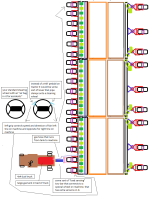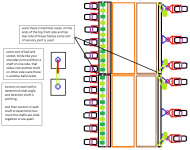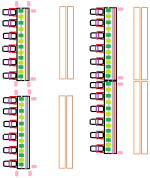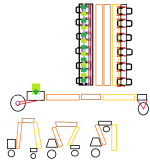OP
boggen
Elite Member
- Joined
- Feb 22, 2011
- Messages
- 3,824
- Location
- Trivoli, IL
- Tractor
- SSTT (Sideways Snake Tain Tractor) and STB (sideways train box) tractor, dirt harvester
RECAP
View attachment 279379
instead of a typical vehicle / tractor. were an engine is all in one larger chunk. the engine is split into multi "smaller engines" per say. but just enough needed for a cylinder/piston. between each cylinder/piston a hyd pump. goal being a single cylinder/pison is enough to drive the nearby hyd pumps. to keep main shaft some what small.
the main frame that supports all the cylinders/pistons for engine and all the hyd pumps. is honey combed or rather multi pipe welded together, to form the physical frame and help give enough structure to the main frame to support the forces being put on it. the main frame also triples as a large heat sink. to help dissipate heat from hyd oil. coolant (antifreeze / water mixture).
front wheels located on machine move up and down or flip up and down. to allow adjustment of implement.
with weight of the extremely long engine going across of machine, and then multi wheels in front. it would help give the extra weight on those front tires to help pull implements through dirt.
multi front tires could reduce overall need for larger diameter wheels found on tractors and perhaps use of tires any were from 8" to 24" in diameter.
am thinking treating each section like a separate machine, but with ability to connect these machines side by side. so if one machine was 20' long. you could keep adding the machines together to form something up to say 200 plus feet long with 10 total machines combined side by side. and then folded up for road travel and pulled behind like multi grain wagons or cargo trailers behind a train.
View attachment 279379
instead of a typical vehicle / tractor. were an engine is all in one larger chunk. the engine is split into multi "smaller engines" per say. but just enough needed for a cylinder/piston. between each cylinder/piston a hyd pump. goal being a single cylinder/pison is enough to drive the nearby hyd pumps. to keep main shaft some what small.
the main frame that supports all the cylinders/pistons for engine and all the hyd pumps. is honey combed or rather multi pipe welded together, to form the physical frame and help give enough structure to the main frame to support the forces being put on it. the main frame also triples as a large heat sink. to help dissipate heat from hyd oil. coolant (antifreeze / water mixture).
front wheels located on machine move up and down or flip up and down. to allow adjustment of implement.
with weight of the extremely long engine going across of machine, and then multi wheels in front. it would help give the extra weight on those front tires to help pull implements through dirt.
multi front tires could reduce overall need for larger diameter wheels found on tractors and perhaps use of tires any were from 8" to 24" in diameter.
am thinking treating each section like a separate machine, but with ability to connect these machines side by side. so if one machine was 20' long. you could keep adding the machines together to form something up to say 200 plus feet long with 10 total machines combined side by side. and then folded up for road travel and pulled behind like multi grain wagons or cargo trailers behind a train.



